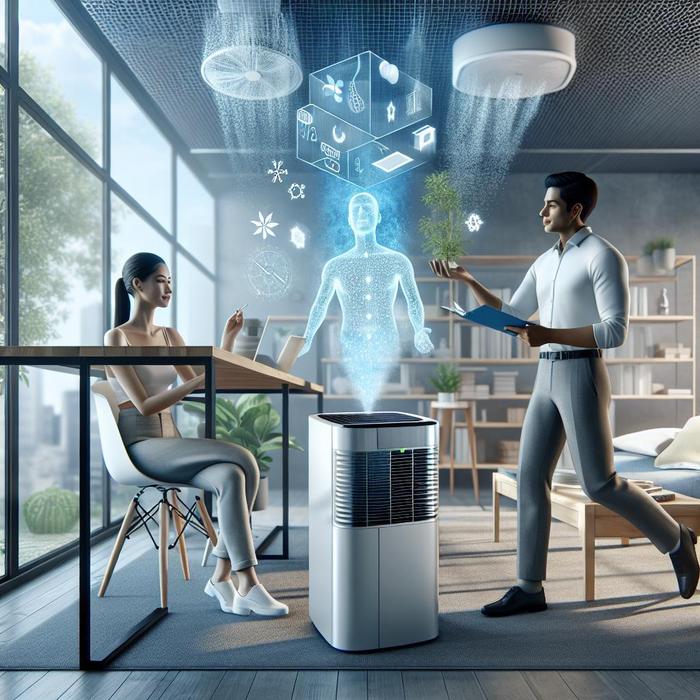Why Controlling Indoor Humidity is Essential
Imagine sitting in your cozy home and suddenly noticing that the walls are damp, the wooden furniture is warping, and there’s a musty smell that you can’t seem to shake off. These are signs of a high indoor humidity level, and it needs immediate attention. High humidity levels can lead to serious consequences, such as mold growth and structure damage. Additionally, a damp environment can also cause health issues, including allergies and asthma.
What is Advanced Dehumidification?
Traditional methods of moisture management, such as ventilation and air conditioning, can only go so far. To truly control humidity levels within your home or business, advanced dehumidification is the way to go. But what does advanced dehumidification entail? Simply put, it is the process of using modern technology and equipment to effectively remove excessive moisture from the air.
An article by Future Bridge discusses how advanced humidity control plays a vital role in semiconductor facilities, which require highly controlled environments. Similarly, advanced dehumidification in homes and businesses can prevent damage caused by excessive moisture.
Benefits of Advanced Dehumidification
Mold Prevention: Mold thrives in damp environments. By controlling humidity levels, you can prevent mold growth, safeguarding the health of your home’s occupants and maintaining structural integrity. Our mold remediation service offers solutions should you need professional help in this area.
Protection of Property: Excess moisture can damage furniture, electronics, and other valuable possessions. Advanced dehumidification can help save your valuable belongings from irreversible moisture damage.
Health Benefits: According to a study published in PubMed Central, properly managing indoor humidity can prevent the spread of airborne viruses, providing a healthier living environment.
Choosing the Right Dehumidification Equipment
Depending on your specific needs, different types of dehumidification equipment are available. Ceiling-mounted dehumidifiers, for example, are a popular choice for their space-saving and efficient performance. An example of this technology, highlighted by Made in China, showcases how these devices provide a solution for moisture control.
Professional Assessment for Humidity Control
Identifying the right dehumidification solution requires an understanding of your property’s unique needs. For instance, the size of the space, existing ventilation systems, and the severity of the moisture problem all influence the choice of dehumidification technology.
We offer a comprehensive assessment that includes a thorough inspection and precise damage estimation. After a flood, this assessment becomes even more critical. Our professionals are trained in environmental and health safety, ensuring that your property is thoroughly assessed and appropriate measures are implemented for effective moisture management.
With the right dehumidification techniques and professional assistance, you can gain control over indoor humidity levels, providing a healthier and safer environment for occupants and preventing potential damage to your property. Take the first step towards advanced moisture management today.
Understanding the Science of Dehumidification
Dehumidification might sound like a complex process, but it’s relatively simple. In a nutshell, dehumidification is the process of removing excess moisture from the air. This is done using a dehumidifier, which draws in humid air, cools it to condense the moisture, and then disperses the dried air back into the room.
The key to effective dehumidification lies in understanding the principles of relative humidity and dew point. When the air’s relative humidity reaches 100%, it has reached its dew point – the temperature at which air becomes saturated and can’t hold any more moisture. Any additional moisture will condense into water droplets. By manipulating these principles, dehumidifiers can effectively control indoor humidity levels.
Your Essential Guide to Advanced Dehumidification Systems
While traditional dehumidifiers suit small spaces, they often fail to control humidity in larger areas or situations with severe moisture issues. Advanced dehumidification systems, on the other hand, offer optimal performance to tackle high humidity levels in larger spaces. For example, advanced systems often incorporate technologies like smart controls and real-time monitoring, which allow for precise humidity control and energy efficiency.
You might wonder if investing in advanced dehumidification is necessary. However, the additional cost is well worth it when considering the potential damage and health risks that uncontrolled humidity can cause. Remember, controlling indoor humidity is not just about comfort; it’s about safeguarding your health and the integrity of your property.
Understanding the Role of HVAC in Dehumidification
A well-maintained HVAC system plays a crucial role in maintaining optimal indoor humidity levels. Heating, ventilation, and air conditioning all have direct impacts on indoor humidity levels. For instance, properly ventilating your space can reduce moisture levels, while heating and air conditioning can affect the relative humidity. The Home Innovation Research Labs detail the correlation between HVAC systems and humidity control in their report.
However, HVAC systems alone may not sufficiently control high humidity levels, particularly in hot, humid climates or spaces with poor ventilation. This is where advanced dehumidification comes in, effectively removing excess moisture and providing a comfortable, healthy indoor environment.
Water damage, whether from a flood, burst pipe, or roof leak, can drastically increase indoor humidity levels. This heightened humidity can lead to further damage, including mold and mildew growth and structural damage. Therefore, it’s crucial to start the dehumidification process as soon as possible after water damage occurs.
A professional water restoration company, like Denver Restoration, is equipped with advanced equipment and expertise to effectively manage the dehumidification process after water damage.
Environmental and Health Safety Concerns in Dehumidification
An important and often overlooked aspect of dehumidification is its impact on environmental and health safety. High humidity levels can lead to the growth of mold and mildew, which are harmful to both the environment and human health.
On the other hand, over-dehumidification can result in too-dry air, which can cause health issues such as dry skin and aggravated respiratory conditions. Therefore, maintaining a balance is crucial – indoor humidity levels should ideally be kept between 30-50%.
As a reliable service provider, we ensure all dehumidification processes are carried out in a safe and environmentally friendly manner. Our professionals are trained in mold remediation, and they use advanced tools for accurate and effective humidity control.
Insurance and Legal Compliance in Dehumidification
Water and mold damage can have significant financial implications. In such cases, insurance can be a lifesaver. However, understanding the terms and conditions of your policy, filing a claim, and following through can be daunting.
We can help! Our professionals are well-versed in navigating the complexities of dealing with insurance companies. We ensure all processes are compliant with legal guidelines and insurance policy requirements.
In conclusion, controlling indoor humidity is a crucial part of maintaining a healthy and comfortable living or working space. By investing in advanced dehumidification technologies and techniques, you can ensure optimal indoor humidity levels and safeguard your property against potential damage. Remember, good indoor humidity control is more than just a luxury – it’s a crucial aspect of property care and maintenance.

